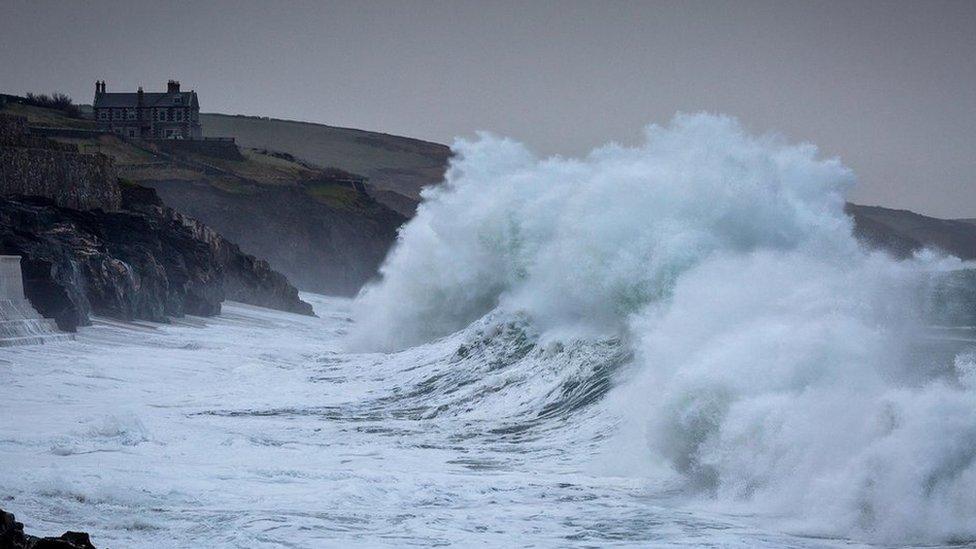Storm Franklin: Why has the UK had so many storms lately?
- Published

Storm Franklin brought disruptive winds to much of the UK on Monday
Storm Franklin is the third named storm to hit the UK in a week - following Dudley and Eunice. It is the first time this has happened since the storm naming system was introduced in 2015.
Why have there been so many storms?
Jet stream explained
The jet stream is a ribbon of fast moving of air about 9km up in the atmosphere and it drives areas of low pressure towards the UK.
During the last week the jet has been very strong, at around 200 mph, over the Atlantic and has deepened successive storms as they got near our shores. It doesn't just stop at the UK but continues right round the northern hemisphere and southern hemisphere too.
Will there be more storms?
The rest of the week will still be windy but not as windy as it has been. The jet stream will be further north and any storms should be further away from the UK.
It is worth keeping in touch with the forecast though as there could be a deep area of low pressure near Iceland on Monday and if it moves further south it could be our next named storm. The next storm that does impact the UK will be called Storm Gladys .
Was Storm Franklin worse than Storm Eunice?
It is difficult to compare storms and say one was worse than the other because rarely, if ever, do two storms impact the same area of the UK in the same way.
Storm Eunice tracked right over the UK and brought the strongest winds to southern areas. Rare Met Office red weather warnings were issued for South Wales and southern England. A gust of 122mph was recorded on the Isle of Wight, provisionally the highest gust speed ever recorded in England.
Damage to the O2 Stadium in London caused by Storm Eunice
Storm Eunice brought the strongest winds during the day, whereas Storm Franklin brought them at night and brought them further north. An amber wind warning from the Met Office across Northern Ireland was valid from midnight to 7am and gusts of around 80mph were recorded in the north of the country.
Unlike Storm Eunice, which brought insignificant amounts of rain, Storm Franklin brought heavy rainfall, and 130mm of rain was measured at Seathwaite in Cumbria. There were more than 100 flood warnings in England and severe flooding in Northern Ireland.
Unprecedented storms
The yellow and amber warning areas for Storm Dudley with predicted wind gusts
A few days before Eunice and Franklin, the UK was hit by Storm Dudley. It is the first time the UK has been battered by three named storms in a week, however, it is worth noting that the naming of storms was only introduced in 2015.
Why are some UK storms given names?
List of UK storm names for the 2021-22 season
During the winter of 2013-14 at least 12 major storm systems affected the UK, which may have prompted the decision to begin them.
The first year storms were named was 2015-16 when there were 11, finishing with Storm Katie in March.
We have never had as many storms in a season since then although in 2018 Storm Hector was named in June. That storm was named by Met Eireann, the Irish Meteorological Service, and had its greatest impacts in the Republic of Ireland.
The naming system is a joint operation with the UK Met Office, Met Eireann and KNMI - the Netherlands Meteorological Service. Each met service has their own criteria for naming storms and not all of them will have a significant impact for the UK, which can lead to some confusion.
The UK Met Office will name a storm based on there being an amber wind warning in the UK.
Weather warnings
How do UK weather warnings work?
The UK Met Office moved to a new warning system in 2011. It is a matrix system based on the likelihood of a severe weather event happening and the impact the weather will have.
Warnings are designated yellow, amber, and the most severe red warning. Since 2011 there have only been 14 red warnings and two of those were issued for Storm Eunice.
You can follow Βι¶ΉΤΌΕΔ Weather on Twitter , on @bbcweather and on Βι¶ΉΤΌΕΔ Online.
- Published1 September 2022
- Published14 February 2022
- Published15 February 2022